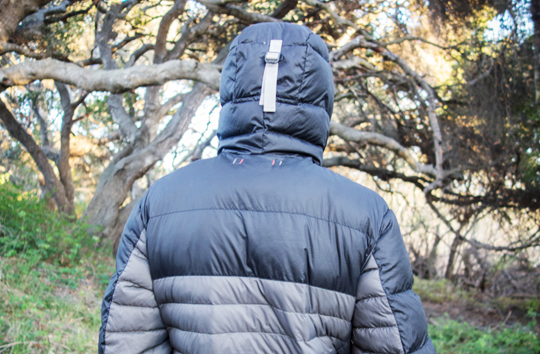MSRP: $180
I’ve been wearing the Mountain Standard Hooded Down jacket practically nonstop for the last three months. It came with me up El Cap this winter, and kept me warm and comfortable at hanging belays and when climbing through the night. I also took it on an overnight fly-fishing trip in Sierra National Forest just outside Yosemite, and wore it the whole time. It’s so warm that I’ve even fallen asleep with it on.
The jacket takes its warmth from its fill: 30 percent PrimaLoft Gold insulation and 70 percent down, which allows it to dry much faster than normal down and also to hold heat when wet. Primaloft Gold blends water-repellent non-fluorocarbon-treated down with synthetic fibers in a way that enhances the best properties in both: the light weight and warmth of down, and the security of warm-when-wet synthetic. The Gold Insulation is comparable in warmth to 750-fill goose down. When I found out that Mountain Standard was using the same PrimaLoft Gold blend that’s in my beloved Black Diamond Cold Forge Hoody, I was pleased. Primaloft Gold shrinks the gap between choosing either down or synthetic in most situations. This is the kind of insulation you want in a jacket for longer technical climbs when you have long belay stints, or may have to bivy while still having peace of mind if the weather turns.
Now to the fit: The Mountain Standard was great when hiking with a pack and never felt cumbersome or in the way. While climbing with it on, I had full range of motion without it riding up.
A bouldering trip to Joshua Tree proved that this hoody could also take a beating as it got stuffed into crash pads several times and had its nylon exterior exposed to the coarse J-tree granite, which it weathered nicely. After being tossed from a few boulders, it showed no signs of tears or abrasions. Plus, the outer material shed light precipitation as I scrambled around California’s foggy coastal cliffs–the exterior is 100 percent nylon with a water-repellent finish. And the jacket is light: it weighed in at only 500 grams for size medium. To test the compressibility, I shoved it into a small ditty bag without a hassle, and it packed down to about the size of a coffee press.
The jacket has an inside zip pocket that is big enough to hold my cell phone and an energy bar, but not quite big enough to hold a water bottle. The sizable hand pockets are insulated with micro fiber. The pockets kept my hands warm, and the pocket’s zippers are big enough to be workable with gloves. Meanwhile, the front zipper has an interior storm flap made of webbing that keeps the wind out and a chin guard for next-to-skin comfort. The stretch gusset cuffs also held strong at retaining heat, and kept out the breeze.

[Photo] Angel Navarro
The hood is probably my favorite feature. It fit snuggly and has an easy-to-use drawstring that cinched down tightly over my bare head or helmet. The back of the hood has sewn-on webbing with a standard slide-release buckle for keeping it cinched down tight and out of the field-of-view. Peripheral vision was fantastic while climbing and hiking. Meanwhile, the hem has an adjustable drawcord that was easy to use with gloves on, but I found that it didn’t hold as tightly as I would like, and I had to re-tighten it often. And there is no belay-friendly two-way zipper.
At $180, the Mountain Standard is priced less than comparative jackets such as the Adidas Terrex Climaheat ($349) and the Black Diamond Cold Forge Hoody ($299).
Of note, Mountain Standard items are only available directly from their website.
All in all, I highly recommend this jacket to anybody looking for a well-designed, affordable puffy that utilizes the latest technology.
PROS: High-quality material; budget-friendly price; great fit; compressible
CONS: Only one color option; only available online; hem drawcord comes loose; no belay-friendly two-way zipper.